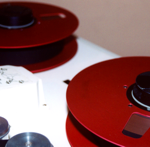
Your Eyes Can Also Deceive You

A few months ago I talked a bit about how what you see can affect your hearing in my Imaging Expectations post. I mentioned how visual cues on stage can actually give a mixer a slight advantage. But there’s another side to this that I’ve been thinking about lately where what we see can actually work against us as mixers.
This is something I was reminded of a few months ago while trying out a new EQ plugin. Plugins and digital desks these days have lots of great looking interfaces that often provide a nice graphic representation of compression and EQ curves. However, the plugin I was using was an old school emulation EQ plug so it was just a bunch of knobs and no curves.
The first thing I noticed was I was getting results I liked faster than I felt like I’d been getting with some of the other digital EQ’s I’d been using. I believe part of this was because the visual component of the gear was altered from what I was growing used to. I wasn’t completely mixing in the dark; the new EQ plugin still had markings for frequency and gain. But the plugin knocked me out of my normal box which is always good from time to time because it centers me back on my ears.
Now, it’s not that I wasn’t using my ears with other EQ’s, but I might have been fighting a bit with what I was growing accustomed to seeing. It was simply another reminder for me that the visual side of our senses has a strong pull. We are, after all, much more reliant on sight than any of our other senses, and I’ve found that there can be a danger with ANY audio gear, old- or new-school, when we start correlating what we hear with what we are used to seeing. If we’re not careful, our ears can get lazy which leads to a couple of things happening: we start to doubt our ears or worse, we rely purely on what we see to dial things in. This is very very bad because when in doubt our brains naturally prefer to believe our EYES before our EARS due to the power of our sense of vision. This can become an even greater challenge in an install world where our scenery and players stay relatively the same. This makes it very easy to get complacent and start falling into visual traps.
So lately I’ve been consciously trying to get away from a lot of the visual stuff I use. I’ve still got it handy, but I tend to bury most of it so it can’t pull my attention away. If I want to see something, I want it to be from a clear choice on my part and not because of something that’s always floating in front of me on one of the many displays sitting at FOH.
Don’t get me wrong, though. I don’t believe this visual stuff is inherently evil. Displays such as RTA’s and EQ and compression curves can be powerful tools. But like all tools there is a time and place for using them, and I just don’t need them all the time.
Plus, always remember, the listeners don’t see everything we might see. They don’t see fader positions. They don’t see EQ settings. They don’t see the meters. These can be helpful visual indicators for us as mixers, but we need to be careful not to rely on these more than our hearing. This is why I try and clear my field of vision when mixing as much as possible with computer monitors pushed to the side and my eyes up and on the band. I often close my eyes to bring my sense of hearing to the forefront of my brain because if the sound can stand on its own, the visuals brought forth from the stage can often make the entire presentation stronger on the audio and visual sides.

 Next Post
Next Post



Dave,
While I have no problem with visual interfaces, I don’t know that I’ve ever run across one that I felt was providing a truly accurate picture of the response of the eq curve. Even the Dolby lake seems to have (small) idiosyncrasies between the infographic and the transfer function curve of the DUT.